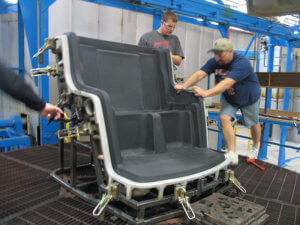Building a Comprehensive Set of Production Drawings
[THIRD OF FOUR SEGMENTS]Production Documentation

At one time, however, not too long ago, production drawings were required to include all geometric details illustrating every feature of the part as well as all dimensions. These drawings were used to machine molds as well as establish production quality standards.
Today the majority of products are designed with the aid of 3D CAD and used by mold makers to machine patterns or molds with CNC machinery. This direct transfer of information from the designer to mold maker eliminates potential errors resulting from interpretation by human intervention. It also places a greater responsibility on the designer to include geometric details affected by parting lines, draft angles and all other mold design related issues in CAD geometries.
 Production drawings are often revised throughout the life of the product.
Production drawings are often revised throughout the life of the product.
Production drawings should be treated as part of a contract between molders, toolmakers and their customer the OEM. A complete drawing package will include assembly drawings and a bill of materials. Depending on the product requirements, production drawings can provide basic information. Or they can provide specific details related to quality, appearance standards, and geometric tolerances stipulating perpendicularity, concentricity, flatness, etc. A well-designed product always includes a comprehensive set of production drawings that are often revised throughout the life of the product.
Production Liaison

More frequently, the first article production samples require some problem-solving intervention by the molder and designer. If parts are designed to properly fit together, problems usually originate from a tooling error, production related issue or a material problem. Experienced designers will refrain from making hasty decisions requiring mold or design changes before careful analysis. A designer’s understanding of part inter-relationships and potential tolerance stack-ups can be helpful in assessing problems with minimal cost or lost time.
Diagnosing originating causes of problems associated with rotationally molded plastic parts can be challenging. Subtle warps on a surface or non-uniform shrinkage can be difficult to detect by a molder, mold maker or designer. If the root cause of these problems is not properly identified, costly, time-consuming tooling revisions can be made that will further exasperate the problem.

The purpose here is to articulate the role of the product designer and critical decisions he or she must face throughout a product development project. Although every project is unique, the basic skills and process of developing a design remain fairly consistent.
Respected designers typically share a common set of traits that include creativity, intelligence, insight, excellent listening skills, effective managerial skills and leadership. A combination of artistic and engineering abilities provides gifted designers with flexibility in their thought process. They are able to see the big picture as well as the minutest technical details associated with any product. These rare qualities provide some designers with an ability to quickly identify the critical factors defining the success or failure of a product.
Transforming an Abstract Concept into a Real Product

The next stage is creating a detailed part design. This phase of design is the most time consuming, challenging and critical in the design process. It requires you to draw upon your technical, creative, and personal skills to transform this abstract concept into a real product.
Technical skills can be acquired with experience, knowledge, and study. But creative and personal skills, on the other hand, are unique to each of us. In my experience, it may not be possible to teach creativity. We cannot change our personalities, but we can improve these traits. The latter two qualities separate mediocre designers from great ones while also providing each of us with a personal stamp or signature.
The translation of a concept into a real manufactured product is a remarkable achievement. Let’s investigate how technical, creative and personal skills provide the magic to transform thought into a physical, mass-produced plastic product.
We are at a phase in product design where we have a visual representation of the desired product and are faced with the challenge of segmenting that concept into specific parts that will satisfy all the product requirements. It’s appropriate to mention that there is no specific path or set of steps that must be followed in this process. The pathway and priorities depend on the product, schedule, budget, company, and financial resources available to you and the design team.
[ARTICLE CONCLUDES WITH SEGMENT FOUR]First Segment | Second Segment | Third Segment | Final Segment

 Production drawings are often revised throughout the life of the product.
Production drawings are often revised throughout the life of the product.